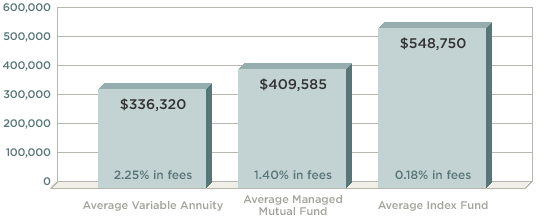Annuities in retirement accounts are an atrocious investment. They are so heinous they make funds involved in revenue sharing schemes, commonly found at many wire houses, look good in comparison. Inexplicably, regulators continue to allow teachers’ retirement accounts to be raided by insurance companies using variable annuities as their Trojan horse.
Jason Zweig recently wrote an article in The Wall Street Journal about the evils of revenue sharing (“Mutual Fund Fees: A Bad Incentive Fades Away”). This practice involves fund companies paying for so called “shelf space.” These companies are paying brokers so they will sell these funds over their competitors who do not participate in this misleading practice.
According to Zweig’s article, “The disclosure statements warn that revenue sharing can be an ethical minefield. Edward Jones says the payments create “an additional financial incentive and financial benefit” to the firm and its advisers. Merrill Lynch points out that funds that don’t enter into such arrangements “are generally not offered to clients.” Morgan Stanley says the firm may “promote and recommend” funds that pay higher revenue sharing.”
“In addition, at Merrill Lynch, fund companies pay up to 0.25% of sales and 0.10% of assets annually for “marketing services and support,” according to a 2015 disclosure. Morgan Stanley collects $750,000 per year from each of 28 fund companies it has designated “global partners” and $350,000 annually from each of another 11 “emerging partners,” according to the firm’s latest available disclosure.”
While this is a rotten deal for investors, it pales in comparison to the typical payout structure annuity salespeople receive for peddling these products to public school teachers. Take a look below. Scott Dauenhauer, who wrote a book on this very issue, shared this schedule with me. Just make sure you read this on an empty stomach.
| Product Differentiation | First Year Commission | Withdrawal Charge | Surrender Period Platinum |
| Platinum | 10% | 14% Yr 1 | 15 Years |
| Gold | 6.5% | 10% Yr 1 | 10 Years |
| Silver | 4.5% | 8% Yr 1 | 7 Years |
How is this even legal? If a Martian descended from the sky and asked for the definition of conflict of interest, this chart would be the prototypical answer. The Platinum dish served by annuity salespeople in the teachers’ cafeteria is laced with financial arsenic.
Let’s use the housing market to put this annuity commission structure into perspective. This would be like adding $50,000 in price to home worth $500,000 to compensate the selling agent. On top of that, if the buyers found out their neighbors were white supremacists and decided to move after six months, they would owe the real estate broker who sold them the house an additional $60,000 (based on the platinum model)!
I doubt many consumers would go for this. Unfortunately in the world of teachers’ 403(b) plans, this is the norm.
These numbers are astonishing. The story gets worse. As Scott states, ” Keep in mind this is just the standard commission schedule, it doesn’t include any perks, trips, deferred compensation or compensation that the company may pay their employees for inducing them to recommend their products.”
Former teacher, Dan Otter, has also done his best to expose these sales practices. Unfortunately most reform is concentrated in the 401(k) universe. This is a major disservice to public school teachers nationwide.
This also does not include the fact that many salespeople “churn” these accounts. Often they roll these products into “new and better” ones in a few years. This enables unethical salespeople to continually collect fresh first year commissions and win new additional company “perks.” In addition, many of these products have “rolling surrender fees.” This means any new money invested starts the cycle from scratch regarding their surrender period!
Over a twenty- or thirty-year time frame, these people can pillage hundreds of thousands of dollars in commissions from their unknowing customers, if they follow this strategy. While insurance companies gorge themselves, very often teachers’ retirement accounts pay a steep price.
The chart below shows the total value of an investment after 35 years, assuming $250 contributed monthly with an 8% annual return. The effects of these charges are devastating.

Source: Meridian Wealth Management
Please, if you know any teachers, pass this post along to them. They are the most likely victims of this conflicted advice. The least we can do is give them a fighting chance.






[…] “Annuities in retirement accounts are an atrocious investment.” […]
[…] Annuity commissions are outrageous. (tonyisola) […]
[…] the all too familiar tale of a broker fleecing his clients with improper annuity sales. As mentioned here, the commission structure of these products creates a breeding ground for unethical behavior. […]
[…] Annuity commissions are outrageous. (tonyisola.com) […]
[…] Source: A Sales Model that Makes Revenue Sharing Look Investor Friendly […]
[…] I have stated here, here, and here, financial predators have used these products to infect 403(b) platforms nation wide. […]
[…] surrender fee attached to this product. This feeling of contentment could also be enhanced by “rolling” the charge. In other words, every new dollar invested starts the whole process over again. Like the Eagles used […]
[…] “Annuities in retirement accounts are an atrocious investment.” […]
… [Trackback]
[…] Read More: tonyisola.com/2016/03/a-sales-model-that-makes-revenue-sharing-look-investor-friendly/ […]